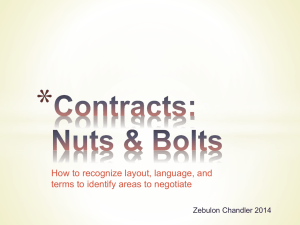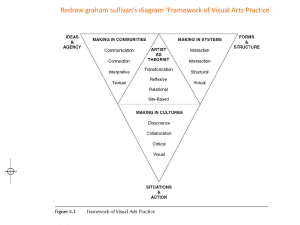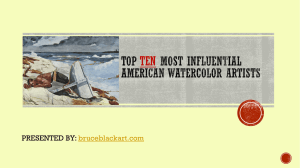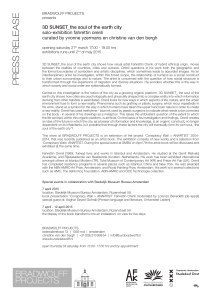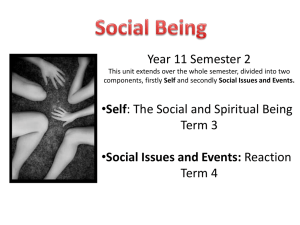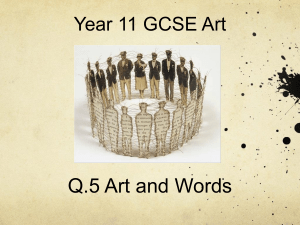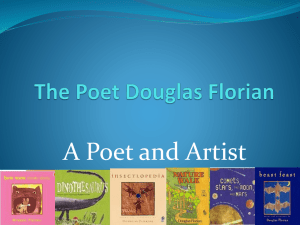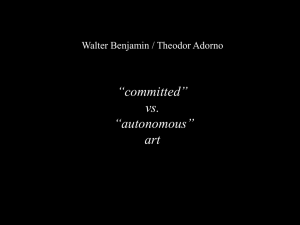Art and Design in the Public Realm
advertisement
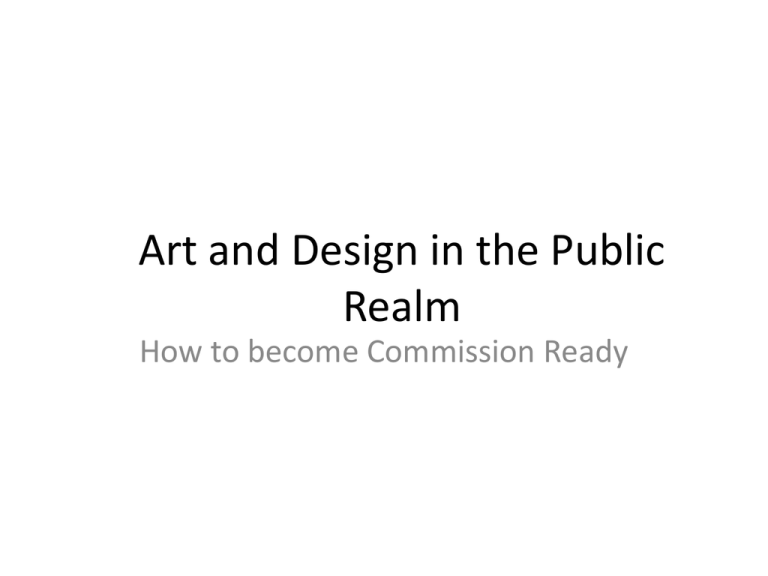
Art and Design in the Public Realm How to become Commission Ready Public art and design Crown Fountains Chigaco. Artist Jaume Plensa Listening Stones Cheltenham. Artist Gordon Young temporary Knit hit commissioned by Milton Keynes Council on Elizabeth Frink scultpture Promenade at Kedleston Hall, Derby. Artist Susie Macmurray Photograph Matthew Andrews temporary Plymouth college photography students temporary shop window project commissioned by Lisa Harty for regeneration project Plymouth City Council. Lighting Artist Jason Bruges Studio Christmas Lights. Artist David Batchelor paving Typeset paving Fakenham. Artist Simon Watkinson Butterfly Paving detail. Artist Linda Schwab Small interventions Animal Kingdom Treehouses. Artist London Fieldworks Pocket Park Gloucestershire. Artist Bews Gorvin Small interventions Carved waymarker. Artist Peter Randall Paige Pavement bosses Cambridge. Artist Michael Fairfax Street furniture Granite, resin and lighting benches. Artist Simon Hitchens Bollards. New Zealand Artist Led Nowhere Island Southwest England. Cultural Olympiad Situations run project Artist Alex Hartley King Bladud’s pigs Bath. Artist led over 100 artists pig prototype designed by Artist Alan Dun Preparing for Opportunities – Sources of information • Who knows What • Understanding how opportunities arise • Developments and trends Image: Dick Weiss window. Are you set up to.. • Record ideas and possibilities • Develop opportunities • Reflect on past projects • Build relationships • Keep records of useful contacts Image: One of postcard series to accompany weather sensitive light works in paving at Canal Walk Swindon. Artist Natalie Woolf Analysing potential opportunities • • • • What are the benefits? Money? Profile? Collaboration? Other? Feasibility • Is the commission consistent with your aims? • Does it fit your work schedule? • Does it suit your way of working? • Any disadvantages? Image. Whale bone seats at Scotland Natural History Museum. Artist Walter Jack You and Your Work Images Bone Memory triptych and still from War Women Wiltshire and Swindon History Centre. Artist Lou Hamilton Analyse and rebalance. Look at how your work balances out: Making – Teaching –Studio group – Research – Recording – Management and co-ordination Types of commission • Lead Artist • Working with design team • Mentored artist • Engagement or community artist • Working to a developer • Working to a project manager • Community led • Working to a local authority Unpacking a Brief Secret Classroom Dunnalley School Cheltenham. Artist Tracy Hager Your response to a brief • What do you instinctively respond to or reject and why? • Fee • Status and expectations of commissioning body • Selection process • Timescale realistic • Who is managing? • What experience do • you need/have? What you should show • You are confident and capable • A good communicator • Good at planning and time management • Aware of any issues • Have clarity of vision • Have undertaken research Image: weather responsive paving Canal walk Swindon. Artist Natalie Woolf The Practicalities Insurance Procurement issues – equal opps, sustainable policies Evidence and track record Approach to the commission Initial sketch ideas Maintenance info. Technical back up Contract confidence So you’ve got the commission • Clarity on your and others roles and status • Management and reporting/documenting mechanisms • Consultation and community engagement • Presentations and launch • Fitting in to the contract demands • Relationships and collaborations SWOT • Short term aims • Medium term aims • Long term aims • Rebalance strengths and weaknesses Image. Cycle path Cambridge. Artist Katy Hallet “Presentation is of the utmost importance. Many artists subscribe to the view that the quality of the concept is paramount and therefore it will shine through a sketchy presentation. However a panel will be prejudiced against an artist who makes a shoddy presentation as an indication of lack of care and organisational skills.” Deanna Petherbridge Art for Architecture
